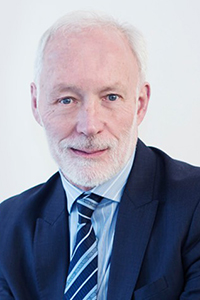Treating Psychosis Patients Early and Comprehensively Has Resulted in Improved Outcomes
Treating Psychosis Patients Early and Comprehensively Has Resulted in Improved Outcomes

A new approach to treating schizophrenia is based on a revamping of the way patients are treated, and when they are treated, relative to the onset of the illness. Spearheading much of the new and more optimistic research on treating schizophrenia is an Australian doctor, Patrick McGorry. In 2015, the Foundation awarded its prestigious Lieber Prize for Outstanding Achievement in Schizophrenia Research to Dr. McGorry for efforts that have “shifted the therapeutic paradigm for schizophrenia to early detection and intervention in young people.”
Early intervention has resulted in some eye-opening results in Dr. McGorry’s research that have given hope to many. To cite one example, in a trial involving 661 patients with first-episode psychosis, published last September in Social Psychiatry and Psychiatric Epidemiology, Dr. McGorry and colleagues reported that 63 percent reached “symptomatic remission” and 44 percent reached “functional remission.” (The former involves significant moderation or disappearance of symptoms; the latter signifies the ability to function in society, in a job, for instance). This was their status 18 months after receiving treatment for a first episode of psychosis, in centers for youth that Dr. McGorry and colleagues established to deliver this care, which stress a comprehensive approach including social and vocational rehabilitation.
In order to detect and intervene early in young people who are at high risk of psychosis, have just had a first episode of psychosis, or have begun to experience symptoms associated with schizophrenia, there needs to be a system of care that is ready to receive them, and that young people know about and are not afraid to access. In a nutshell, this has been the focus of Dr. McGorry’s work and a cause he has been laser-focused on since the 1980s, and his efforts and political acumen have resulted in the creation in his native Australia of a system of mental health care geared to young people that might be considered revolutionary.
We asked him how he came to the idea that early intervention might change the course of schizophrenia, especially in light of the pervasive traditional view of the illness which stresses its incurability. “It started back in 1984, when I was still a trainee psychiatrist,” he said. “I had the opportunity, when I moved to Melbourne, to set up a research unit for schizophrenia, which was a new thing in those days in Australia. We didn’t have any research units focusing on that illness.”
He and his colleagues decided to focus on first-episode psychosis patients. Since psychosis occurs in several illness (including bipolar disorder and depression, although in a much smaller fraction of cases than in schizophrenia) this meant the focus was on “the psychotic break,” but not the specific diagnosis of the individual. This would be an important aspect of the model that would emerge from his experimental treatment program.
“We noticed three things pretty quickly,” Dr. McGorry recalls. “First, our first-episode patients were young – teenagers or young adults, in the majority of cases. Second, they had long delays in getting treatment. It was usually something like a suicide attempt or an aggressive incident or some other kind of crisis that propelled them into treatment – often under traumatic and draconian circumstances, with police and handcuffs, coercive measures, involuntary treatment.
“The third thing we noticed was that they were terrified, because they were being brought into a mental hospital surrounded by people who were middle-aged, with the most severe, disabling illnesses. And psychiatrists were telling them things like, ‘this is a terrible, devastating illness; you’ll never get better; your life will now be very different.’”
At this early moment in his career, Dr. McGorry was stopped in his tracks. “All of those things were absolutely shocking to me – that such things could be happening! I had decided to train in psychiatry because I wanted to do something positive. And yet, I saw that there was so much harm being done to patients.”
As time passed, he noticed a fourth theme. In his view, patients “were being given 10 to 20 times as much antipsychotic medication as they really needed to get better.” At the same time, there was no real psychosocial treatment being offered. These observations provided the impetus for all that has followed in Dr. McGorry’s career. “We decided to try to turn all of this around – to basically challenge the idea that these people couldn’t get better.”
The new approach began with a decision “to try to limit the harm by using very low doses of medication,” but was accompanied by efforts to address the developmental and family needs of patients, “which were quite different from the needs of middle-aged chronic patients” receiving care in the hospital, he says.
At this early stage, the program was being run in a part of Royal Park Hospital, a chronic-care mental hospital in Melbourne. “But after a while we realized we needed to be based in the community, and using the hospital as a kind of backup system, rather than the other way around,” Dr. McGorry says. The result of moving into the community, to treat young people where they lived, led to the development of a program called EPICC, which was extensively described in papers published by McGorry and colleagues in the 1990s. A major success that has been adopted in other nations in the intervening years, EPICC begins with the premise that psychosis causes acute distress in young people experiencing it for the first time, as well as among their family and friends, and that this distress needs to be attended to.
In retrospect, Dr. McGorry says, “what we have been trying to do is apply principles established in the care of heart disease and cancer, to psychiatry. Once we ‘found’ our patients, we didn’t discard them after initial treatments. Can you imagine doing that in cancer? With cancer, there’s a premium on early diagnosis; then you treat the patient as consistently and intensively as you can, or as is necessary, according to disease stage, until the patient gets better or dies. That has saved a lot of lives. It’s also lengthened the lives of many people who would have died more quickly. In other words, cancer treatment is disease-modifying. Whereas, in the way that serious psychiatric illness is treated, there is often revolving-door neglect.” Patients who lack insurance or the means to get first-rate care must access the public health system, where typically they “are patched up, episode to episode, but they are not maintained,” he said.
This situation, acknowledges Dr. McGorry, has a great deal to do with the failure of governments to effectively replace chronic long-term care in psychiatric hospitals with an effective community mental health system. Australia had very poor resources with which to deal with the psychiatric problems of the general population, and nothing that was geared to find and treat people in their late adolescence and early adulthood, the time in life when so many mental illnesses begin to manifest.
He has since received backing from various sectors, including Australia’s national government, to establish youth mental health centers nationwide. There are now over 110 such centers – called “headspace” clinics – and more are on the way. There is no publicly backed equivalent in the United States, although various localities in the U.S. and Europe have invited Dr. McGorry to help them design systems along the lines of the headspace centers he has established back home.
“I think what our experiment has shown is that when we do for first-episode psychosis patients what is done for those with serious physical illnesses, you get similar results,” he says. “We’ve shown this not only with early intervention for psychosis, but also in extending this idea to a broader youth mental-health paradigm, one that applies to all the emerging disorders in teenagers and young adults.”
— Written By Peter Tarr, Ph.D.
Click here to read the Brain & Behavior Magazine's March 2018 issue



